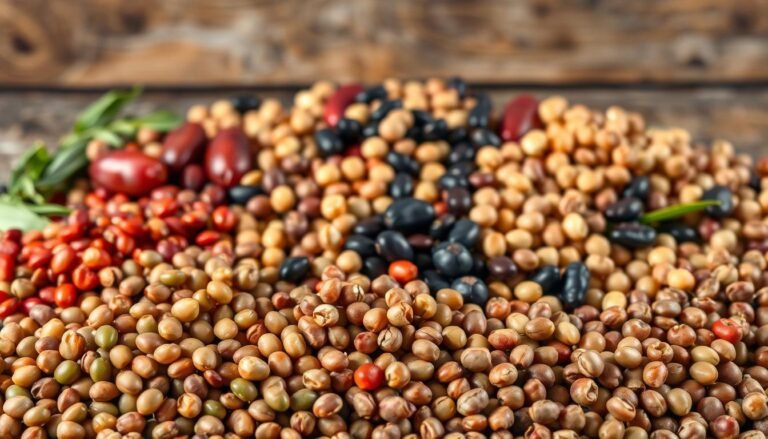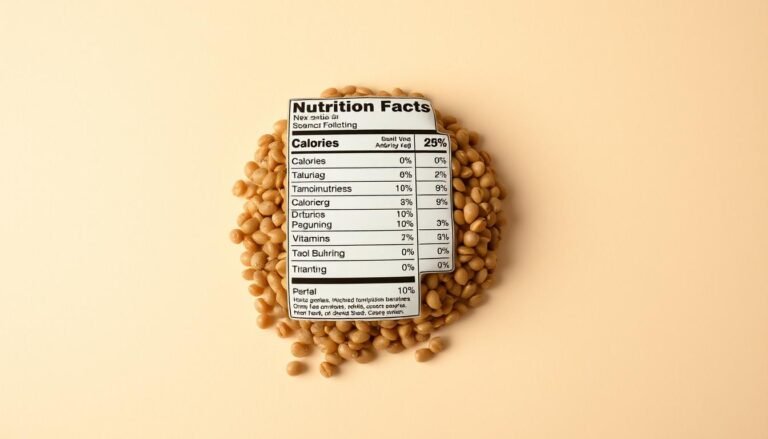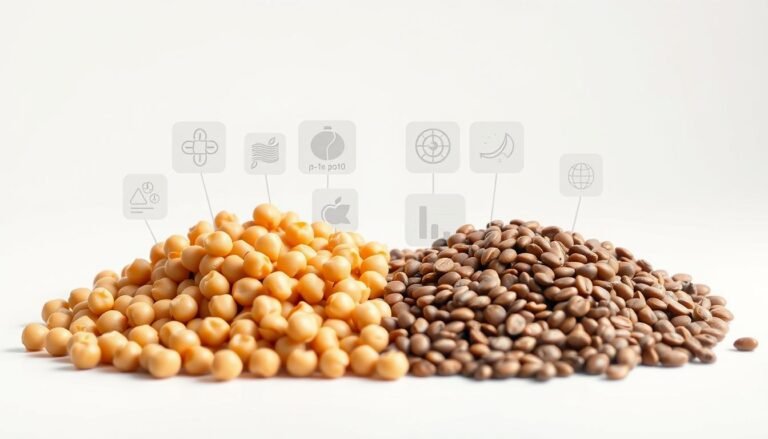Lentils are a nutrient-dense food that has been a staple in many cuisines for centuries. Incorporating lentils into a plant-based diet can have numerous health benefits, from supporting weight loss to promoting gut health.
The versatility of lentils makes them an excellent addition to a variety of dishes, from soups to salads. They are rich in nutrients and can help reduce inflammation and oxidative stress, supporting overall well-being.
Key Takeaways
- Lentils support weight loss and gut health.
- Incorporating lentils into a plant-based diet can reduce inflammation.
- Lentils are rich in nutrients and versatile in cooking.
- A plant-based diet rich in lentils can support heart health.
- Lentils can help reduce oxidative stress.
The Nutritional Powerhouse: Understanding Lentils
As a versatile and nutritious legume, lentils have gained popularity globally for their health benefits and culinary uses. Lentils are a type of legume that is native to North America and Western Asia but is now enjoyed worldwide in various dishes.
What Are Lentils?
Lentils are small, disk-shaped seeds that come in a variety of colors, including green, brown, red, yellow, and black. They are a rich source of nutrients, including proteins, fibers, and minerals. Lentils are also known for their ability to thrive in poor soil conditions, making them a sustainable crop.
Historical Significance and Global Usage
Lentils have been a staple in many cuisines for thousands of years, with evidence of their consumption dating back to ancient civilizations in the Middle East and Mediterranean. Today, lentils are used in a wide range of dishes, from soups and stews to curries and salads, across various cultures.
| Region | Popular Lentil Dishes |
|---|---|
| Middle East | Lentil soups, stews |
| India | Dal, lentil curries |
| Europe | Lentil salads, soups |
Why Lentils Are Gaining Popularity in Australia
In recent years, lentils have gained popularity in Australia due to their nutritional benefits, versatility in cooking, and sustainability. Australian consumers are increasingly looking for plant-based protein sources, and lentils fit perfectly into this trend.
Lentil recipes for health are becoming more mainstream, with many chefs and home cooks incorporating lentils into their meals. The growing awareness of the health benefits of lentils, including their high protein and fiber content, is driving their increased use in Australian cuisine.
Nutritional Profile of the Healthy Lentil
Lentils are a nutritional powerhouse, offering a rich blend of macronutrients, vitamins, and minerals that contribute to their numerous health benefits. As a nutrient-dense food, lentils provide a significant amount of essential nutrients while being relatively low in calories.
Macronutrient Breakdown
Lentils are composed of a balanced mix of macronutrients, making them an excellent source of energy and nutrition. The breakdown includes:
Protein Content
Lentils are an excellent source of plant-based protein, containing about 18 grams of protein per 1 cup cooked serving. This makes them an ideal protein source for vegetarians and vegans.
Carbohydrates and Fiber
Lentils are rich in complex carbohydrates and high in dietary fiber, with a single serving providing approximately 16 grams of fiber. This high fiber content supports healthy digestion and satiety.
Fat Profile
Lentils are low in fat, with less than 1 gram of fat per 1 cup cooked serving. The fat present is primarily polyunsaturated and monounsaturated, contributing to heart health.
Vitamin and Mineral Content
Lentils are a good source of various vitamins and minerals, including folate, iron, zinc, and potassium. Folate is particularly important for cell division and growth, while iron supports healthy red blood cells.
The mineral content in lentils also includes manganese, copper, and phosphorus, contributing to overall health and supporting various bodily functions.
Antioxidants and Phytonutrients
Lentils contain a range of antioxidants and phytonutrients that help protect against oxidative stress and inflammation. These compounds contribute to the potential health benefits of lentils, including reduced risk of chronic diseases.
The antioxidant profile of lentils includes polyphenols and other phytochemicals that have been associated with improved health outcomes.
Lentils for Weight Management
As a nutrient-dense food, lentils are particularly beneficial for individuals aiming to manage their weight. Incorporating lentils into a plant-based diet can provide a feeling of fullness and support overall nutritional balance.

How Lentils Promote Satiety
Lentils are rich in dietary fiber and protein, making them highly effective at promoting satiety. The combination of fiber and protein slows down digestion, keeping you feeling fuller for longer. “Lentils are an excellent addition to a weight loss diet because they are so satiating,” notes a nutrition expert. This can lead to a reduction in overall calorie intake, supporting weight management efforts.
Low Calorie, High Nutrient Density
Lentils are characterized by their low calorie count and high nutrient density, making them an ideal food for those managing their weight. A serving of cooked lentils is low in calories but rich in essential vitamins and minerals, contributing to a balanced diet without excessive calorie intake.
Stabilizing Blood Sugar Levels
The fiber in lentils also plays a crucial role in stabilizing blood sugar levels. By slowing the absorption of sugar, lentils help prevent spikes in blood glucose.
Glycemic Index of Lentils
Lentils have a low glycemic index (GI), which means they have a minimal impact on blood sugar levels. This low GI is beneficial for weight management as it helps avoid the insulin resistance associated with high GI foods.
Impact on Insulin Response
The slow digestion rate of lentils results in a gradual release of glucose into the bloodstream, thereby moderating insulin response. This moderation is key to maintaining metabolic health and supporting weight management.
By incorporating healthy lentils into your meals, you can leverage their nutritional benefits to support your weight management goals. Whether you’re following a plant-based diet or simply looking to add more nutrient-dense foods to your meals, lentils are a versatile and valuable choice.
Heart Health Benefits of Lentils
The consumption of lentils has been associated with various heart health benefits, making them a valuable addition to a heart-healthy diet. Lentils are rich in nutrients, including fiber, protein, and various minerals that contribute to their heart health benefits.
Cholesterol-Lowering Properties
Lentils are high in soluble fiber, which can help lower cholesterol levels by binding to bile acids and removing them from the body, thus reducing the amount of cholesterol produced in the liver. This cholesterol-lowering effect can significantly reduce the risk of heart disease.
Blood Pressure Regulation
Lentils are also beneficial for regulating blood pressure due to their rich content of potassium and magnesium. These minerals play a crucial role in maintaining healthy blood pressure levels.
Potassium and Magnesium Content
Potassium helps to balance sodium levels in the body, while magnesium supports the relaxation of blood vessels, both of which are essential for maintaining healthy blood pressure.
Research on Hypertension
Studies have shown that a diet rich in potassium and magnesium can help reduce the risk of hypertension, a major risk factor for cardiovascular disease.
Reducing Cardiovascular Disease Risk
The combination of lentils’ cholesterol-lowering properties, blood pressure regulation, and high nutrient content makes them an effective food for reducing the risk of cardiovascular disease. Incorporating high fiber foods like lentils into your diet can be a simple yet effective step towards a healthier heart.
Lentils and Digestive Health
Rich in fiber and nutrients, lentils play a significant role in supporting gut health and overall well-being. The high fiber content in lentils is particularly beneficial for maintaining a healthy digestive system.
Fiber Content and Gut Microbiome
Lentils are an excellent source of dietary fiber, containing both soluble and insoluble fiber. This fiber is crucial for promoting a healthy gut microbiome, as it acts as a prebiotic, feeding the good bacteria in the gut. A robust gut microbiome is essential for proper digestion, immune function, and even mental health.
“A diet rich in fiber is associated with a lower risk of digestive disorders.” The fiber in lentils helps to regulate bowel movements, preventing constipation and reducing the risk of diverticulitis.
Prebiotic Properties
The prebiotic properties of lentils are a significant contributor to their digestive health benefits. By nourishing the good bacteria in the gut, lentils help to create a balanced gut microbiome. This balance is crucial for optimal digestive health and overall well-being.
Managing Digestive Disorders
Lentils can play a role in managing various digestive disorders due to their high fiber and nutrient content. For individuals with specific digestive issues, lentils can be a valuable addition to their diet.
IBS Considerations
For individuals with Irritable Bowel Syndrome (IBS), lentils can be both beneficial and challenging. While they are high in fiber, which can help regulate bowel movements, some people with IBS may experience discomfort due to their high fiber content. It’s essential to introduce lentils gradually into the diet to assess tolerance.
Colon Health
The fiber in lentils also supports colon health by promoting regular bowel movements and preventing the buildup of toxins in the colon. A healthy colon is less susceptible to diseases such as colon cancer.
In conclusion, lentils are a nutritious food that can significantly contribute to digestive health. Their high fiber content, prebiotic properties, and nutrient richness make them an excellent addition to a healthy diet.
Types of Lentils and Their Unique Benefits
Exploring the various types of lentils reveals a spectrum of nutritional benefits and culinary possibilities. Lentils are not just a single entity; they come in a variety of colors, sizes, and textures, each with its unique characteristics and uses.

Brown Lentils
Brown lentils are one of the most commonly consumed types. They have a mild flavor and firm texture, making them ideal for soups, stews, and salads. Brown lentils are rich in fiber and protein, supporting heart health and digestive well-being. They are also relatively inexpensive and widely available.
Green Lentils
Green lentils are similar to brown lentils in terms of nutritional profile but have a slightly peppery flavor. They hold their shape well when cooked, making them suitable for salads and side dishes. Green lentils are a good source of iron and potassium, contributing to healthy blood circulation and blood pressure regulation.
Red and Yellow Lentils
Red and yellow lentils are known for their vibrant colors and slightly sweet flavor. They cook more quickly than green or brown lentils and are often used in Indian cuisine, particularly in dal recipes. These lentils are rich in antioxidants and fiber, supporting overall health and digestive efficiency.
Black and Specialty Lentils
Black lentils, also known as beluga lentils, have a shiny black appearance and a robust, earthy flavor. They retain their shape after cooking and are often used in salads and as a side dish. Specialty lentils like Puy lentils from France are known for their dark green color and rich flavor. These lentils are not only delicious but also packed with nutrients and antioxidants, making them a healthy addition to various meals.
Understanding the different types of lentils and their unique benefits can help you incorporate a variety of healthy lentil recipes into your diet. Whether you’re looking to support heart health, manage weight, or simply enjoy delicious meals, there’s a type of lentil that can meet your needs.
| Type of Lentil | Nutritional Highlights | Culinary Uses |
|---|---|---|
| Brown Lentils | High in fiber and protein | Soups, stews, salads |
| Green Lentils | Good source of iron and potassium | Salads, side dishes |
| Red and Yellow Lentils | Rich in antioxidants and fiber | Indian dal recipes, soups |
| Black Lentils | Packed with nutrients and antioxidants | Salads, side dishes |
As you explore the world of lentils, you’ll discover that incorporating these versatile legumes into your diet can be both delicious and nutritious. With their variety of types and numerous health benefits, lentils are an excellent addition to any meal, supporting overall health and well-being.
Lentils as a High-Quality Plant Protein Source
For those following a plant-based diet, lentils are an invaluable resource for high-quality protein. Lentils have been a staple in many cuisines around the world for centuries, and their nutritional benefits are now being recognized globally.
Protein Content Comparison
Lentils are known for their high protein content. To put this into perspective, let’s compare the protein content of lentils with other common foods.
| Food Item | Protein Content per 100g |
|---|---|
| Lentils | 9g |
| Chicken Breast | 31g |
| Tofu | 8g |
| Quinoa | 4g |
Amino Acid Profile
Lentils are not only high in protein but also provide a good mix of essential amino acids. According to Medical News Today, lentils are a good source of amino acids, although they are low in methionine. They can be paired with other foods like grains to create a complete protein profile.
Benefits for Vegetarians and Vegans
For vegetarians and vegans, lentils are a valuable component of a balanced diet. They provide the necessary protein for muscle repair and growth. Moreover, lentils are rich in fiber, iron, and other essential nutrients, making them a nutritious addition to meals.
Lentils are a versatile ingredient that can be incorporated into a variety of dishes, from soups to salads. Their nutritional benefits, coupled with their ease of preparation, make them an ideal choice for those seeking to enhance their diet with high-quality plant protein.
Incorporating Lentils into a Plant-Based Diet
Lentils are a versatile and nutritious addition to any plant-based diet, offering numerous health benefits. They can be used in a variety of dishes, from soups to salads, and can even serve as a meat substitute in many recipes.
Lentils as Meat Substitutes
Lentils can be an effective meat substitute due to their high protein content and meaty texture. When using lentils as a meat substitute, it’s essential to consider texture and flavor.
Texture and Flavor Considerations
The texture of cooked lentils can vary from mushy to firm, depending on the cooking time. Flavor can be enhanced with spices and herbs, making lentils a versatile ingredient in many dishes.
Recipe Conversions
When converting recipes to use lentils instead of meat, consider the protein content and adjust seasonings accordingly. Lentils absorb flavors well, making them a great canvas for various cuisines.
Complementary Protein Pairings
Pairing lentils with other plant-based proteins can create a balanced and satisfying meal. Grains like rice or quinoa, when paired with lentils, provide a complete protein profile.
Balanced Meal Planning with Lentils
Incorporating lentils into meal planning can ensure a balanced intake of nutrients. Lentils are rich in fiber, protein, and various vitamins and minerals, making them a nutritious addition to a plant-based diet.
By incorporating lentils into your diet, you can enjoy a variety of healthy lentil recipes that support overall health and well-being.
Cooking with Lentils: Basic Techniques
Lentils are a versatile ingredient, and understanding how to cook them is key to incorporating them into your diet effectively. Whether you’re looking to prepare a hearty stew or a simple salad, mastering the basics of lentil cooking can elevate your culinary skills.
Soaking vs. No Soaking
One of the first decisions you’ll need to make when cooking lentils is whether to soak them beforehand. Soaking can reduce cooking time and make lentils easier to digest. However, it’s not always necessary, especially for smaller varieties like red or yellow lentils. For larger lentils, such as green or brown ones, soaking for 30 minutes to an hour can be beneficial.
Tip: If you choose to soak your lentils, make sure to rinse them thoroughly afterward to remove any remaining impurities.
Cooking Times for Different Varieties
Cooking times can vary significantly depending on the type of lentil you’re using. Here’s a quick guide:
| Lentil Variety | Cooking Time |
|---|---|
| Red Lentils | 20-25 minutes |
| Green or Brown Lentils | 30-40 minutes |
| Black Lentils | 25-30 minutes |
Storage and Preparation Tips
Proper storage and preparation are crucial for maintaining the quality and nutritional value of your lentils. Store lentils in a cool, dry place, and rinse them before cooking to remove any debris. For meal prep, cooked lentils can be refrigerated for up to three days or frozen for longer storage.
By following these basic techniques, you can enjoy lentils in a variety of healthy lentil recipes, from soups to salads, enhancing both the nutritional value and flavor of your meals.
Healthy Lentil Recipes for Every Meal
Exploring the world of lentil recipes can open up new flavors and textures for a healthier eating experience. Lentils are incredibly versatile, making them a perfect ingredient for a variety of dishes across different meals.
Breakfast Ideas
Starting your day with lentils can be both nutritious and delicious. Consider a lentil breakfast bowl with sautéed vegetables and a fried egg on top, or lentil pancakes made with red lentils for a protein-packed breakfast.
Lunch and Dinner Recipes
For lunch or dinner, lentils can be the star of the dish. A hearty lentil soup or lentil curry can be very satisfying. You can also make lentil burgers as a healthier alternative to traditional burgers.
Snacks and Sides
Lentils aren’t just for main meals; they can also be used in snacks and sides. Lentil hummus is a tasty dip for vegetables, and roasted lentil salad makes a great side dish.
Australian-Inspired Lentil Dishes
Australia’s diverse cuisine offers many opportunities to incorporate lentils into local dishes. You can make lentil and vegetable stir-fry with bush tomatoes or create a lentil and lamb kofta for a unique twist on traditional recipes.
Using Local Ingredients
When cooking with lentils, incorporating local Australian ingredients can enhance the flavor and nutritional value of your dishes. Consider using native herbs or local vegetables to give your lentil recipes a unique Australian touch.
Seasonal Adaptations
Adapting your lentil recipes to the seasons can keep your meals fresh and exciting. In winter, a warm lentil stew is comforting, while in summer, a cold lentil salad can be very refreshing.
Potential Concerns and Considerations
Lentils offer numerous health benefits, but it’s essential to be aware of potential concerns. While they are a nutritious addition to a healthy diet, certain factors should be considered to maximize their benefits.
Antinutrients in Lentils
Lentils, like other legumes, contain antinutrients such as phytates and oxalates. These compounds can interfere with the absorption of minerals like iron and zinc. However, soaking, sprouting, or cooking lentils can significantly reduce antinutrient levels, making their nutrients more bioavailable.
Digestive Adjustment Period
For individuals new to consuming high fiber foods like lentils, there may be a digestive adjustment period. It’s recommended to gradually increase lentil consumption to allow the gut microbiome to adapt, minimizing potential discomfort such as bloating or gas.
Who Should Exercise Caution
Certain individuals should be cautious when consuming lentils. This includes people with specific medical conditions or those taking certain medications.
Medical Conditions
Individuals with conditions like irritable bowel syndrome (IBS) may need to monitor their lentil consumption due to their high fiber content. Additionally, those with kidney issues should be mindful of the potassium content in lentils.
Medication Interactions
Lentils are rich in vitamin K, which can interact with blood thinners like warfarin. Individuals on such medications should maintain a consistent intake of vitamin K-rich foods, including lentils, to avoid fluctuations in medication efficacy.
In conclusion, while lentils are a healthy addition to most diets, being aware of these potential concerns can help individuals enjoy their nutritional benefits while minimizing any adverse effects.
Lentils vs. Other Legumes: A Comparative Analysis
A comparative analysis of lentils and other legumes reveals distinct differences in nutrition, cooking methods, and health benefits. Legumes are a diverse group of plants that are united by their high nutritional value and versatility in cooking. Lentils, in particular, stand out for their high protein content and low fat levels.
Nutritional Differences
Lentils are compared to other legumes like chickpeas, black beans, and kidney beans in terms of nutritional content. While all these legumes are rich in protein and fiber, lentils have a slightly different nutritional profile. For instance, lentils have a higher iron content compared to some other legumes.
| Legume | Protein Content (%) | Fiber Content (%) | Iron Content (mg) |
|---|---|---|---|
| Lentils | 25-30 | 10-15 | 6-7 |
| Chickpeas | 20-25 | 12-15 | 4-5 |
| Black Beans | 20-25 | 9-12 | 3-4 |
Cooking and Versatility Comparison
Lentils are known for their relatively quick cooking time compared to other legumes. They can be cooked in under 30 minutes, making them a convenient option for meal planning. In contrast, other legumes like chickpeas and kidney beans may require longer cooking times or soaking.
The versatility of lentils is also noteworthy. They can be used in a variety of dishes, from soups and stews to salads and curries. Their mild flavor makes them a great base for many recipes.
Health Benefit Variations
While all legumes offer numerous health benefits, the specific advantages of lentils include their high antioxidant content and ability to help lower cholesterol levels. The fiber in lentils also supports healthy digestion and satiety.
In conclusion, lentils offer a unique combination of nutritional benefits, culinary versatility, and health advantages that make them a valuable component of a plant-based diet.
Sustainable Benefits of Choosing Lentils
Lentils are a powerhouse of nutrition and sustainability, offering a triple win for personal health, the environment, and local economies. As the world shifts towards more sustainable eating habits, lentils stand out as a versatile and environmentally friendly food choice.
Environmental Impact
Lentils have a low environmental footprint compared to other protein sources. They require less water to cultivate and can thrive in poor soil conditions, making them an ideal crop for sustainable farming practices. “Lentils are a drought-tolerant crop, which means they can be grown in areas with limited water resources,” making them a valuable resource in regions prone to water scarcity.
Economic Advantages
Choosing lentils can also have significant economic benefits. By supporting lentil farming, consumers are directly contributing to the local economy, particularly in regions like Australia where lentil production is a growing industry. This support can lead to job creation and stimulate local economic growth.
Supporting Australian Farmers
By opting for lentils grown in Australia, consumers are supporting local farmers and contributing to the country’s agricultural sector. This not only helps in maintaining the local economy but also promotes sustainable agricultural practices. As noted by agricultural experts, “Supporting local farmers through the purchase of locally grown lentils can significantly boost regional economies.”
In conclusion, incorporating lentils into your plant-based diet is a simple yet effective way to promote sustainability. With their numerous health benefits and low environmental impact, lentils are indeed a healthy lentil choice for both individuals and the planet.
Conclusion: Making Lentils a Regular Part of Your Healthy Diet
Incorporating healthy lentil into your diet can have numerous health benefits, from supporting weight management to promoting heart health. With their high nutrient density and versatility in cooking, lentils are an excellent addition to a plant-based diet.
By exploring various lentil recipes for health, you can enjoy the benefits of these high fiber foods while savoring delicious meals. Whether you’re looking to stabilize blood sugar levels, lower cholesterol, or simply add more protein to your diet, lentils offer a range of benefits that make them an ideal choice.
As you’ve seen, lentils come in a variety of types, each with its unique characteristics and uses. By incorporating lentils into your meal planning, you can not only enhance your nutritional intake but also support sustainable food choices.
Start experimenting with lentils today and discover the many ways they can enhance your diet and overall well-being. With their rich nutritional profile and culinary versatility, lentils are sure to become a staple in your kitchen.





